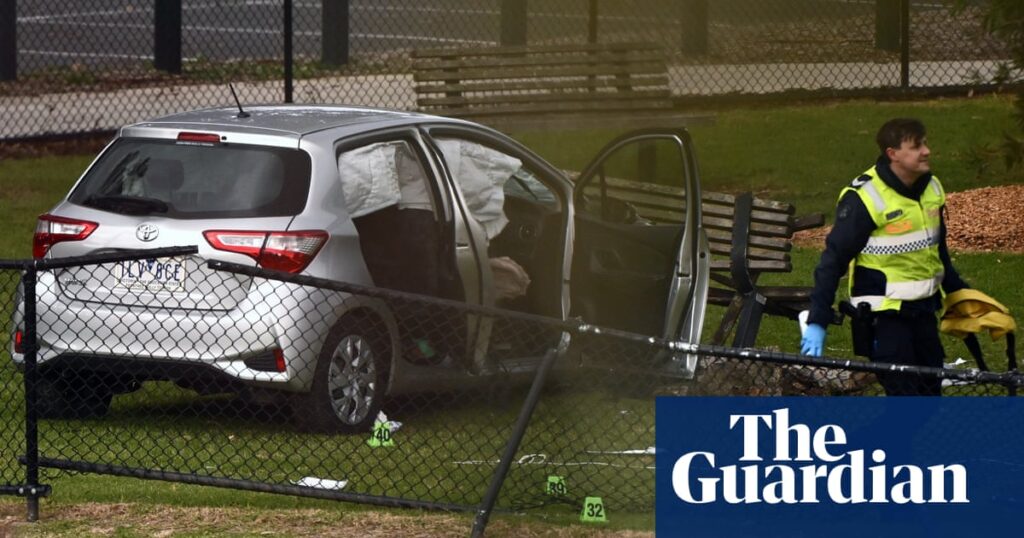The Victorian government is considering increasing testing for elderly drivers after a 91-year-old woman lost control of her car near a playground and struck three pedestrians, killing one.
The acting premier, Ben Carroll, said his thoughts were with the family of the female pedestrian who died on Thursday afternoon on Coleman Road in Wantirna South in Melbourne’s east.
The woman, 59, died at the scene while a man, 60, suffered life-threatening injuries alongside a two-year-old boy, who is now in a stable condition in hospital.
Victoria police have not yet revealed the connection between the three victims, but they are believed to be related.
“My heart, as every Victorian’s, just breaks for this family and what they’re going through and our thoughts are with them,” Carroll told reporters on Friday.
When asked whether elderly Victorians should be required to prove their fitness to drive, Carroll acknowledged it was a valid concern.
“In relation to people that are elderly and driving, I think it is a valid question that you raise around testing. I will work with the road safety minister on this,” he said.
“There are a range of initiatives in place through our general practitioners right around Victoria when it comes to making sure that Victorians continue to get tested for their driver’s license. But I think this, no doubt this tragedy has brought it into focus.”
In 2024, the Royal Australian College of General Practitioners called for Victoria to introduce age-based regulations for drivers in line with other jurisdictions including New South Wales, Queensland, ACT, Tasmania and the Northern Territory, which require drivers over 75 to have a health check.
The age is 80 in Western Australia, while older drivers in South Australia must complete self-assessments.
At the time, the Victorian government rejected the call, arguing drivers aged 75 already had to renew their licence every three years, which could include various tests.
Police on Friday morning were yet to interview the 91-year-old driver, who was treated in hospital for minor injuries. They said she lost control of her Toyota Yaris about 12.20pm on Thursday, mounted a footpath, went through a fence and hit a bench.
Supt Justin Goldsmith said the adults and child were walking in the same direction as the car was travelling when it struck them.
“It came from behind,” Goldsmith told reporters.
“It looks like it’s [lost control] about 40 metres or 50 metres before the collision with the people who were walking on the other side of that road.”
The out-of-control car continued down the road for another 200 metres, hitting a street sign and smashing through a fence before coming to a stop near a playground.
“No one was hit at the park, thankfully,” Goldsmith said.
The driver, who was “terribly shaken”, had minor scratches and was taken to hospital for assessment and blood testing.
Police will look at whether speed was a contributing factor.
“That will be subject to the investigation, but it is downhill section of road, so if there has been a lack of control to some degree there is a possibility the car would have picked up speed as it’s driven further down Coleman Road,” Goldsmith said.
The crash happened during the first week of Victorian school holidays, bringing the state’s road deaths to 14 in the past seven days.
“We’re facing a horrific month for road trauma,” Goldsmith said.
The state has seen a number of deadly crashes involving out-of-control vehicles in recent years.
In November, a teacher’s aide was killed and a three-year-old boy injured when a runaway truck smashed through the gate of a kindergarten in the regional town of Riddells Creek, about 57km north-west of Melbourne.
Two weeks earlier, an 11-year-old boy was killed and four other students injured when an SUV crashed through a fence at Auburn South Primary School in Melbourne’s east.
Five people were killed and six injured in November 2023 when a diabetic driver passed out behind the wheel and crashed into patrons seated outside the Royal Daylesford Hotel.
The driver was charged but the allegations were ultimately struck out after a magistrate found there was not enough evidence to support a conviction.


